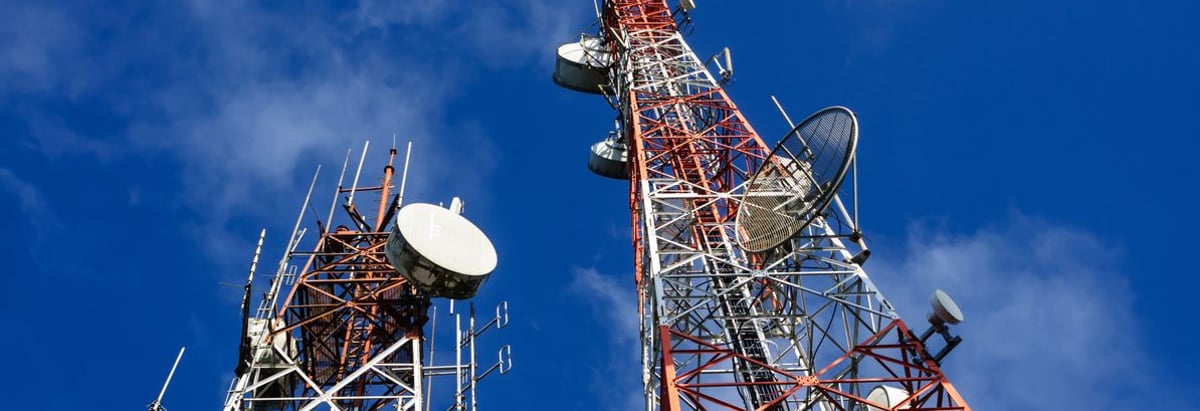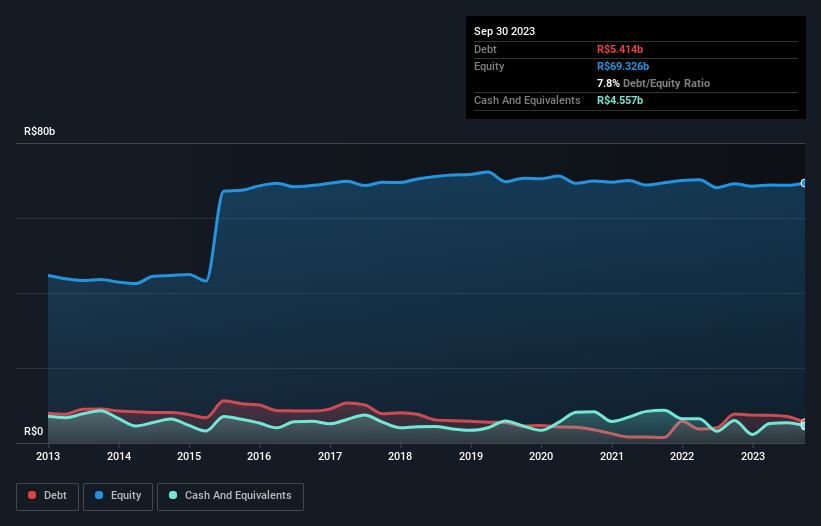- Brazil
- /
- Telecom Services and Carriers
- /
- BOVESPA:VIVT3
These 4 Measures Indicate That Telefônica Brasil (BVMF:VIVT3) Is Using Debt Reasonably Well

The external fund manager backed by Berkshire Hathaway's Charlie Munger, Li Lu, makes no bones about it when he says 'The biggest investment risk is not the volatility of prices, but whether you will suffer a permanent loss of capital.' When we think about how risky a company is, we always like to look at its use of debt, since debt overload can lead to ruin. Importantly, Telefônica Brasil S.A. (BVMF:VIVT3) does carry debt. But should shareholders be worried about its use of debt?
When Is Debt Dangerous?
Debt assists a business until the business has trouble paying it off, either with new capital or with free cash flow. If things get really bad, the lenders can take control of the business. However, a more usual (but still expensive) situation is where a company must dilute shareholders at a cheap share price simply to get debt under control. Of course, plenty of companies use debt to fund growth, without any negative consequences. When we think about a company's use of debt, we first look at cash and debt together.
See our latest analysis for Telefônica Brasil
How Much Debt Does Telefônica Brasil Carry?
As you can see below, Telefônica Brasil had R$5.41b of debt at September 2023, down from R$7.72b a year prior. However, because it has a cash reserve of R$4.56b, its net debt is less, at about R$857.0m.

How Strong Is Telefônica Brasil's Balance Sheet?
Zooming in on the latest balance sheet data, we can see that Telefônica Brasil had liabilities of R$21.0b due within 12 months and liabilities of R$29.6b due beyond that. Offsetting this, it had R$4.56b in cash and R$11.6b in receivables that were due within 12 months. So it has liabilities totalling R$34.5b more than its cash and near-term receivables, combined.
While this might seem like a lot, it is not so bad since Telefônica Brasil has a huge market capitalization of R$86.3b, and so it could probably strengthen its balance sheet by raising capital if it needed to. But we definitely want to keep our eyes open to indications that its debt is bringing too much risk. But either way, Telefônica Brasil has virtually no net debt, so it's fair to say it does not have a heavy debt load!
In order to size up a company's debt relative to its earnings, we calculate its net debt divided by its earnings before interest, tax, depreciation, and amortization (EBITDA) and its earnings before interest and tax (EBIT) divided by its interest expense (its interest cover). This way, we consider both the absolute quantum of the debt, as well as the interest rates paid on it.
Telefônica Brasil's net debt to EBITDA ratio is very low, at 0.055, suggesting the debt is only trivial. But EBIT was only 5.7 times the interest expense last year, so the borrowing is clearly weighing on the business somewhat. Importantly, Telefônica Brasil grew its EBIT by 39% over the last twelve months, and that growth will make it easier to handle its debt. The balance sheet is clearly the area to focus on when you are analysing debt. But it is future earnings, more than anything, that will determine Telefônica Brasil's ability to maintain a healthy balance sheet going forward. So if you want to see what the professionals think, you might find this free report on analyst profit forecasts to be interesting.
Finally, a company can only pay off debt with cold hard cash, not accounting profits. So the logical step is to look at the proportion of that EBIT that is matched by actual free cash flow. Over the last three years, Telefônica Brasil actually produced more free cash flow than EBIT. That sort of strong cash generation warms our hearts like a puppy in a bumblebee suit.
Our View
The good news is that Telefônica Brasil's demonstrated ability to convert EBIT to free cash flow delights us like a fluffy puppy does a toddler. And the good news does not stop there, as its EBIT growth rate also supports that impression! Zooming out, Telefônica Brasil seems to use debt quite reasonably; and that gets the nod from us. While debt does bring risk, when used wisely it can also bring a higher return on equity. When analysing debt levels, the balance sheet is the obvious place to start. However, not all investment risk resides within the balance sheet - far from it. For example, we've discovered 1 warning sign for Telefônica Brasil that you should be aware of before investing here.
Of course, if you're the type of investor who prefers buying stocks without the burden of debt, then don't hesitate to discover our exclusive list of net cash growth stocks, today.
Valuation is complex, but we're here to simplify it.
Discover if Telefônica Brasil might be undervalued or overvalued with our detailed analysis, featuring fair value estimates, potential risks, dividends, insider trades, and its financial condition.
Access Free AnalysisHave feedback on this article? Concerned about the content? Get in touch with us directly. Alternatively, email editorial-team (at) simplywallst.com.
This article by Simply Wall St is general in nature. We provide commentary based on historical data and analyst forecasts only using an unbiased methodology and our articles are not intended to be financial advice. It does not constitute a recommendation to buy or sell any stock, and does not take account of your objectives, or your financial situation. We aim to bring you long-term focused analysis driven by fundamental data. Note that our analysis may not factor in the latest price-sensitive company announcements or qualitative material. Simply Wall St has no position in any stocks mentioned.
About BOVESPA:VIVT3
Telefônica Brasil
Operates as a mobile telecommunications company in Brazil.
Solid track record and fair value.
Similar Companies
Market Insights
Community Narratives



